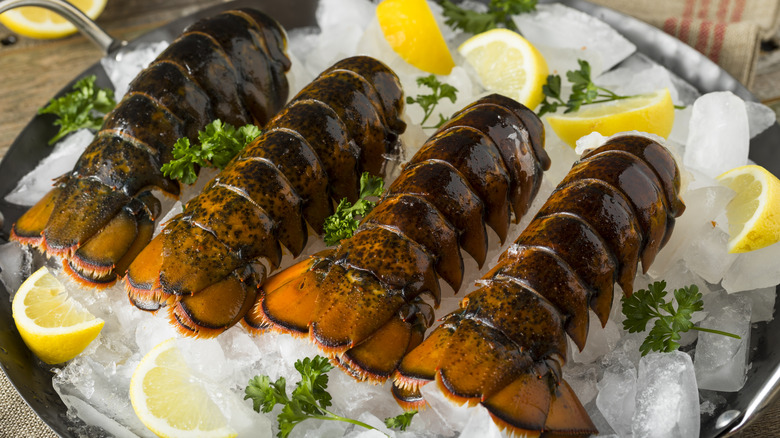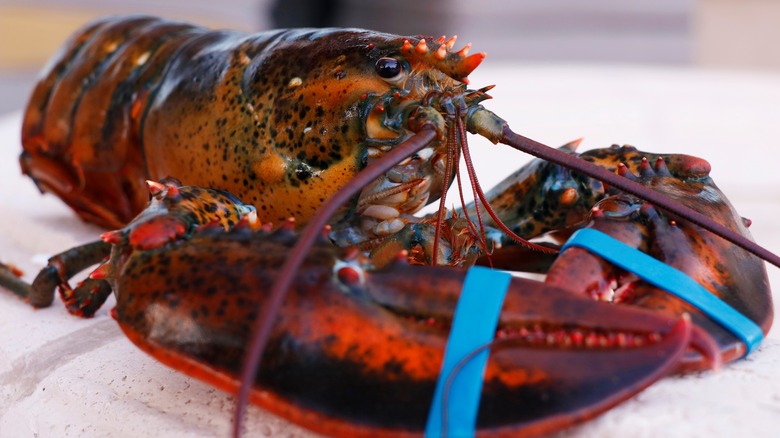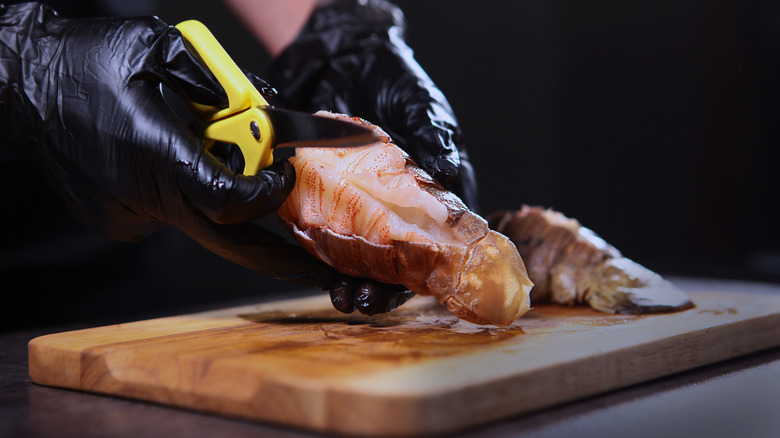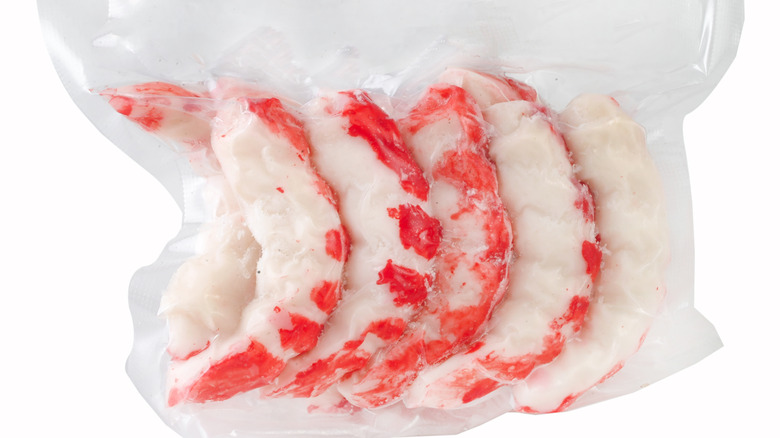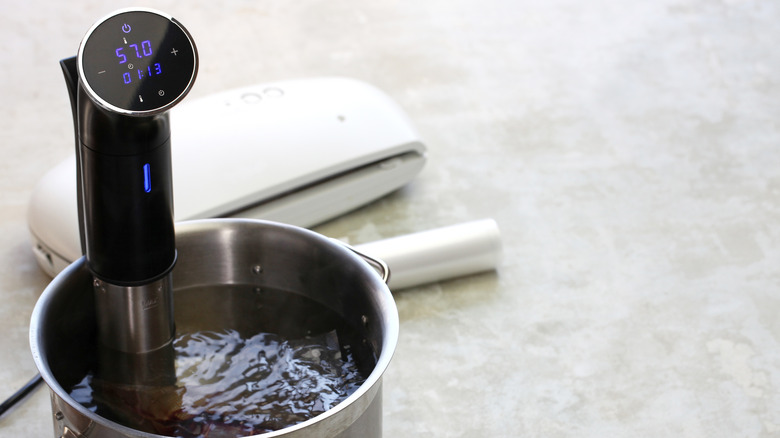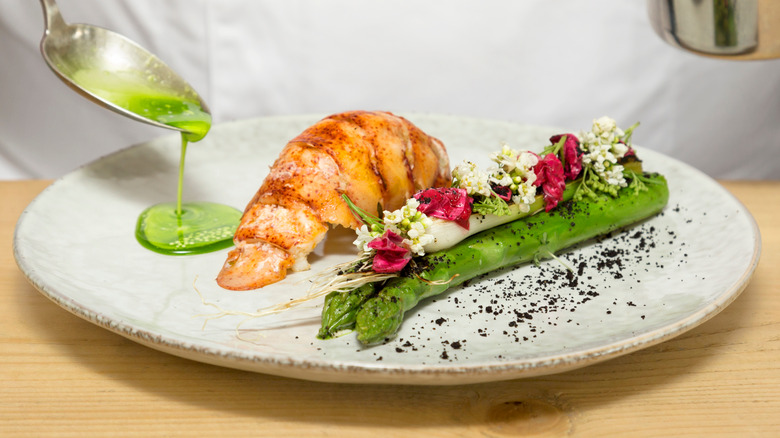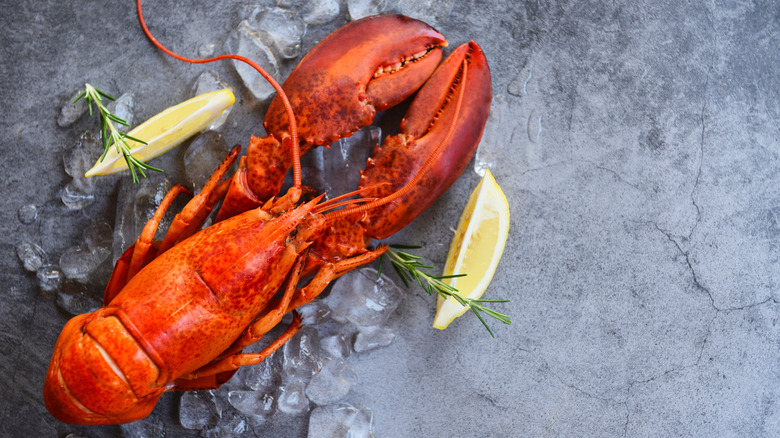How To Sous Vide Lobster Tail
Sous vide is a cooking technique that has taken the culinary world by storm. This process involves cooking vacuum-sealed bags of food in a water bath at a controlled temperature. The French term "sous vide" literally translates to "under vacuum" in English (via Merriam-Webster). A sous vide machine — also referred to as an immersion circulator — keeps the water at a stable temperature, so you can slowly cook your food to perfection. According to Arizton Advisory & Intelligence, sous vide machine purchases are increasing, and with the growing popularity of this culinary technology, more home cooks are able to recreate popular restaurant dishes.
While steak is the most common dish created with the sous vide cooking method, there is a wide range of foods that work well with the technique. One of the absolute best foods to cook sous vide is lobster. Lobster tails are a luxurious treat: The plump, meaty tails are considered the most prized part of this crustacean. However, given the high price of lobster, you don't want to risk overcooking them. What could be more disappointing than spending all that money on lobster just for it to turn into rubber? Sous vide is an ideal technique for cooking lobster tails because you will always end up with tender meat. By following these guidelines, you can sous vide lobster tail for the best results every time.
Buy high-quality lobster
When it comes to seafood, not all sources are created equal; there are a lot of poor-quality products on the market. You might be shocked by how long it takes "fresh" seafood to get from the ocean to your plate. That said, the freshest way to get lobster is to buy them live. However, dealing with live lobsters is not for the faint of heart. Plus, this is not the most economical choice if you only want the tail meat. You'd be better off buying just the tails.
When buying lobster tails, specifically, frozen tails are a surprisingly good choice. Look for lobster that is flash-frozen right after being caught. When defrosted, the meat is likely more "fresh" than lobster tails that have sat in the seafood case at the supermarket for who knows how long — and may have also been frozen at some point. There are even several companies that will ship high-quality frozen lobster tails directly to you, which can be of great value to those who do not live near New England; according to NOAA Fisheries, 93% of all harvested American lobster comes from Maine and Massachusetts.
Remove the tail meat from the shell
To sous vide lobster tail, you'll first want to remove the meat. Lobster shells offer great flavor, but all those sharp edges can too easily puncture the vacuum seal bags they'll go in. Don't throw away the shells, though. They can be turned into a really flavorful stock when simmered with aromatics like onion, celery, carrots, fennel, garlic, and bay leaves.
If using frozen tails, defrost them in the fridge for 8 to 10 hours before cooking. To prepare your lobster tails, place the tails bottom-side up on a cutting board. Use kitchen shears to cut slits down each side of the underbelly of the shell. Then, peel the underside of the shell away from the meat and pull both sides of the shell apart, revealing the meat that should easily come out.
One last thing before you can cook: Check for a black vein that runs through the center of the tail. This is the lobster's intestinal tract, and you'll want to remove it. While not harmful, you probably don't want to eat lobster poop.
Prepare the sous vide bags
Once you have all the tail meat out of the shells, it is time to prepare your sous vide bags. Make sure you have the proper food-grade vacuum seal bags. In a pinch, you can use a Ziploc bag, as they are BPA and dioxin-free. However, you won't quite get the full effect as a vacuum-sealed bag. If you do choose to use a Ziploc bag, try to push as much air out as possible before closing the bag (Tip: try the displacement method). One benefit of using a vacuum sealer is getting an intensified flavor out of your lobster, as this method helps concentrate it more.
Adding aromatics like garlic and fresh herbs to the bag will make a noticeable difference in your final dish. But, no matter what other ingredients you use, it is highly recommended to add butter to the bag. One tablespoon of butter per tail will result in succulent, buttery meat you won't be able to resist.
Sous vide the lobster tails
The most important aspects of sous vide cooking are time and temperature. These factors will determine the texture of your lobster tails.
Preheat the water bath until it reaches a temperature between 130 and 140 F using your sous vide machine. Note: You may notice that this range is lower than the standard used to poach foods (160 to 180 F). However, sous vide is an even gentler cooking method. Ultimately, the best temperature setting for you depends on how you like your lobster meat. According to A Duck's Oven, 130 F will result in tender, juicy meat, while 140 F will give you firmer meat more similar to the "traditional" texture served in restaurants.
Once preheated, add the bag of lobster to the water bath and cook for 45 minutes. Secure the bag to the side of the water vessel to keep it stable during cooking. After the time has elapsed, you are all set to remove the meat from the bags and enjoy.
Serve the lobster tails
Sous vide lobster tails will be plenty appetizing on their own, especially if you used butter during cooking. However, they will taste even better with a sauce or dressing. Lobster tails love a compound butter, such as the one in a broiled lobster tails recipe with lemon, tarragon, and garlic. Mix aromatics like garlic, lemon zest, and fresh herbs into softened butter and brush over top of the hot tails for a flavor-packed finish. You can also dip the meat into melted butter.
If you want to feel like you are at a fine-dining restaurant, use reserved lobster shells to create a homemade stock for a rich sauce. When reduced, the lobster flavor in will concentrate. A lobster and white wine reduction will give you a luxurious sauce. Once the reduction is thickened to your desire, swirl in a tablespoon or two of butter to achieve what the French call "nappe," which is when a sauce has the consistency that coats the back of a spoon (via Food Republic). Spoon this sauce over top of the lobster and sprinkle on some fresh herbs, and you'll feel like you just won "Master Chef."
Meal prep lobster tails to sous vide later
If cooking lobster for 45 minutes while getting the rest of dinner together sounds daunting, you can sous vide the lobster ahead of time, making dinner prep on the actual day easier. This would be a great idea if you want to make lobster during the week but don't have the time to do the whole process at once. You can cook the meat over the weekend and store it in the fridge until it's ready to serve.
Sous vide the lobster tails as described above. Then, immediately put the bag into an ice bath. This will not only shock the lobster, stopping any carryover cooking, but it will also quickly cool down the lobster so it will be safe to put away in the fridge. The meat will keep inside the vacuum-sealed bag for roughly two to three days. The general consensus is that you should reheat the lobster at a slightly lower temperature than you cooked it; using the sous vide method, reheat the lobster at about 120 F for 20 minutes before serving (via Two Kooks in the Kitchen).
